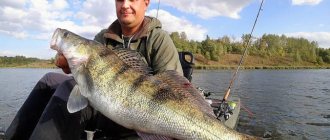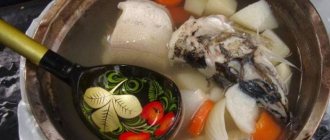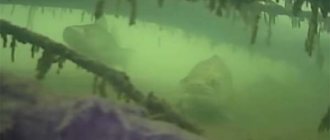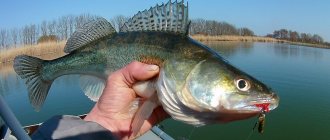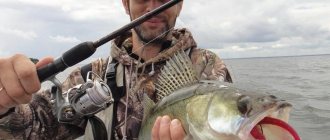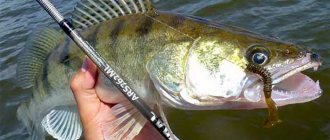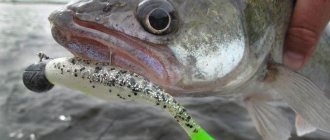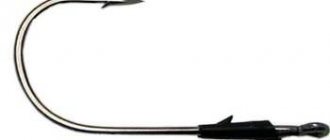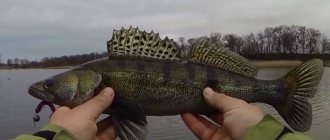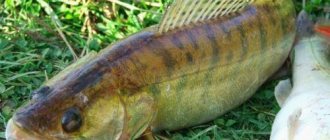Yuri 12/24/2020 398
Experienced spinners have long included spinnerbaits in their arsenal. For beginners, its use raises more questions. Not everyone understands how one can catch predatory fish with such bait. But in fact, it has long proven itself on the positive side. The main thing is to know how to choose the right spinnerbait for perch and a good catch will be guaranteed.
What is a spinnerbait?
The name "spinnerbait" is translated from English: spinner - rotating spoon, bait - bait. Spinnerbaits are composite baits that combine the basic qualities of a spinner and silicone jig baits.
The spinnerbait does not require any special skills when using it. It is quite versatile and is suitable for fishing on the surface, in thick water, near the bottom, in clear, muddy water. It is used more often for catching pike; other predatory fish in our reservoirs do not refuse it.
As you know, the main predator lives near grass and snags. In this regard, the main feature of a spinnerbait is its ability to protect the tackle from snags even in the most difficult-to-reach, “strong” places for a spinning rod.
Bait device
A standard spinnerbait consists of two main parts:
- “skirt” - a hook with a weight or a jig head with feathering in the form of a bunch of rubber (silicone). The hook is hidden in the “skirt”. Instead of feathers, a twister, vibrotail, made of silicone can be used. The jig head must impart a certain weight and maintain its position in the water column;
- concave-convex petal, reminiscent of the petal of a spinner. This component is called the spinnerbait lure. Unlike a regular spinner, the petal plays a different role here. It creates a vibration that is transmitted to the second part - the “skirt”, which the fish grabs. The petal should rotate easily, create vibration, sound vibrations and a trail of bubbles behind it.
Both elements are connected at an angle of 90 degrees with a special rocker arm made of thin wire. The rocker arm must have a significant degree of rigidity and elasticity, due to which the entire structure of the tackle is supported and the vibration of the spoon petal is transmitted to the “skirt”. The rocker also helps the bait pass through areas that are heavily overgrown with grass, “paving the way” for the remaining parts.
Thanks to the unusual design, both parts of the rocker create a unique game that attracts predators from a very long distance.
Varieties
There are many varieties that differ in appearance and shape. Distinctive features may be the weight, size, material of the petal, color, quantity, size of the petals of the spinner, the shape of the rocker arm, the types of attachments on the “skirt” hook.
There are several main types:
- standard spinnerbaits with one blade and a tuft of silicone located on a jig head with a hook;
- baits with several petals located one after another on the same axis of the rocker;
- spinnerbaits-“catchers”, in which the bunch of rubber on the hook is replaced with silicone bait: twister, vibrotail, and other baits;
- Bassbait is a large spinnerbait for pike. Instead of a petal, a propeller with a low rotation speed is installed. Bassbaits follow the surface of the water, leaving behind small breakers with a characteristic sound that quickly spreads through the water. They can be considered highly specialized, used exclusively for pike fishing.
There are three modifications of the petal shape:
- Willowleaf - long and narrow, resembling a willow leaf;
- Colorado - wide, rounded;
- Indiana - similar in shape to the Colorado, but longer and somewhat narrower.
They can be painted or galvanized, smooth or grooved.
Types of spinnerbaits
There are several types of spinnerbaits, which differ from each other in the number of blades and minor design features:
- single-petal models are classic lures with one petal attached to the upper arm of a metal wire frame. At the bottom there is a silicone skirt that covers the hook;
- two-petal type - a widespread and attractive model for predators with two petals located in the upper part of the frame. A special feature of the design is the presence of two petals with different trajectories of movement, creating vibrations of different frequencies in the water column;
- multi-leaf models - spinnerbaits that have more than two petals in the upper part of the rocker;
- “catchers” are baits, the main difference of which from classic models is a full-fledged silicone bait mounted on a hook, on the lower rocker, instead of a silicone skirt.
Another evolved variation of the spinnerbet is the buzzbait. This bait is much smaller than the classic “spinner”. Its main difference from other species is the presence on the upper arm of the rocker arm of a miniature turbine or propeller, which, in addition to the visual impact, attracts predatory fish with a noise effect.
Design Features
The design of the bait is aimed at solving two problems:
- attract the predator as much as possible;
- protect the tackle from snags.
When retrieving, the vibration of the petal is transmitted to the “skirt” or jig bait attached to the hook. The vibration creates a unique game that attracts the predator.
Another feature is ideal maneuverability in difficult places. The vertical position of the bait is ensured by a weight on one arm of the rocker and a spoon on the other. With the help of a rocker, the spinnerbait spreads the grass in front of it and can roll over obstacles. A silicone “skirt” or vibrating tail, mounted as a non-snag, also avoids all possible places of hooks.
Wiring
The spinnerbait is not a type of spinning bait that requires active play. To fish with them, it is better to use regular uniform fishing at high speed.
Fast speed prevents the spinnerbait from sinking into the water column, so as not to give the fish extra time to think. There is nothing to worry about if, when guiding, it catches the stems and leaves of aquatic plants. This is an additional incentive to attract fish and the predator to grab the bait. When a pike lies in ambush between aquatic plants and snags, this bait, flying past it at high speed, becomes an ideal irritant that guarantees a fish bite.
Two main types of wiring:
- The uniform type of wiring allows you to catch an active predator and explore large areas of water in search of fish. For fishing in the bottom layer, the wiring should be at a minimum speed, in contrast to high-speed wiring on the surface. Touching the bottom with the bait can provoke the fish to attack;
- The free-fall fishing technique is used to catch differences in depth and edges. A compact spinnerbait with a blade that can rotate when immersed is used. Such wiring is carried out along the depth boundary.
Spinnerbait for perch
Among the variety of spinning baits, such attachments as spinnerbaits deserve special attention. They are radically different from most artificial baits, as they have fundamentally different elements in their design. The point is that in addition to the hook, this type of bait has plumage, as well as a rocker with a petal. Due to this unusual, at first glance, structure of the bait, it is possible to achieve outstanding indicators of biting intensity and catch in general. Such baits can be made independently, however, in this case they will be somewhat inferior to serial models. A spinnerbait for perch, like other models, is distinguished by an extremely expressive action of the bait, which is explained by the presence of a petal and the material used to make the wire. The wire used is distinguished by its elasticity and strength, due to which it perfectly transmits even the lightest vibrations. When fishing with this bait, wiring plays a huge role, since the intensity of the bite and the angler’s catch as a whole directly depend on it. It is important to take into account that this bait is perfect for fishing in any area of the reservoir, since due to its unique structure, it eliminates the possibility of snagging on various objects and obstacles, in which it is somewhat similar to non-catchable rigs. This attachment allows you to use a huge variety of artificial baits available on the market. Wobblers, vibrating tails and other popular products are great for this role. They are attached directly to the hook, which greatly simplifies the process of assembling the nozzle. Since the action of the bait has an incredible impact on the intensity of the bite and, accordingly, the catch, you should learn how to properly perform the retrieve when fishing using an attachment such as a spinnerbait for perch.
This type of bait belongs to the active category, which means that uniform wiring is considered the best option. It is worth adjusting its speed and adapting to the behavior of fish in a particular body of water. For example, if the fish is showing activity, it is advisable to perform it quickly in order to deprive the fish of the opportunity to deliberately think about its actions and force it to attack the bait. Lightly catching aquatic plants, such as water lilies, does not negatively affect the bite, but rather, on the contrary, stimulates the fish’s interest in the bait used. It is also important to know how to choose the right spinnerbait for perch . This is not always easy to do, given the large assortment of similar baits presented in most stores. First of all, you should pay attention to such an element as cargo. Its weight should be selected based on the actual depth in the area where fishing is planned. As the depth increases, the weight of the load must be increased, which contributes to the correct position of the bait, necessary for successful fishing. If you have to fish in those reservoirs where fishing pressure is high, you should be prepared for the fact that the fish will be extremely careful about the bait. To increase the intensity of the bite, experienced fishermen recommend reducing the size of the bait, which will significantly increase the likelihood of bites. The petal is an important element and should be selected separately to achieve optimal fishing results. Its type is selected individually in each case, since the rotation speed of a given element depends on it. To summarize, it is worth noting that this bait is excellent for fishing for perch, and its differences make the spinnerbait one of the best options for these purposes.
Tackle
Fishing with a spinnerbait requires frequent casts and constant maneuvering. The spinning rod should be light, but at the same time could withstand the resistance of a large predator. Fish can take bait into thickets of vegetation or snags, so the gear must be strong.
A fast, medium-fast action rod is recommended. Length 2−2.5 meters. Test up to 25 gr. A reliable reel that can withstand heavy loads is a must. Spinning rods are well suited for twitching. It is better to use braid, the diameter of which depends on the size of the fish. A strong, long leash is a must; its rigidity does not affect the game in any way.
Spinning equipment for catching pike perch with a spinnerbait
To catch pike perch with spinnerbaits, spinning rods with a weight of 7 to 30 grams are used. It can be a medium or a heavy guitar with a medium-hard tuning. The length of the fishing rods varies from 2.4 to 3.5 meters. Longer models are relevant when fishing from the shore at long distances, and shorter ones are used when fishing from a boat or from the shore, but in the coastal zone.
For a spinning rod, we will put a reel with a spool capacity of 2000 to 3000. The further you throw, the larger the reel we use. It must be strong. It is better to wind a strong braid with a cross section of 0.16-0.2 onto the reel. Often you have to catch pike perch on a rocky or shell bottom. The fishing line, even fluorocarbon, will quickly become unusable during step-by-step wiring. There is no need to use leashes when fishing for pike perch.
Bait selection
There are no universal models of spinnerbaits, as well as other artificial spinning lures. Only by experience can a specific shape, petal color and silicone of the scout bait be selected, which will help to examine an unfamiliar body of water for predator activity.
When choosing, you should adhere to the following rules:
- the weight of the load depends on the depth of the line at the fishing point;
- for places with significant fishing pressure, it is better to choose compact baits;
- the color, size of the petal and silicone depend on the transparency of the water, lighting, and type of fish.
DIY spinnerbait
If you are not satisfied with the branded design of the lures, the high price, or you want to try something new, you can make a spinnerbait or bassbait with your own hands without spending a lot of time and effort on it.
Manufacturing technology
Materials needed to make a spinnerbait with your own hands: 1 mm wire, a hook with a long shank, winding rings and a swivel, several beads, one or two petals (you can use petals from spinners), a casting mold and lead.
Optimal sizes:
- length of the upper shoulder - about 3 cm;
- length of the lower one - 3.3 cm;
- total weight - 5 g.
Manufacturing process:
- a wire with a good degree of elasticity is threaded into the eye of a hook fixed in a casting mold. This is the first arm of the bait;
- The mold is filled with lead and a load is obtained. The more lead, the heavier;
- using pliers, the wire is bent until it takes the shape of a rocker arm;
- A petal is put on the second arm of the rocker wire through a clamp or bow; the second petal is attached to a wire loop using a carabiner and a swivel. The presence of two petals is not necessary. One blade is often enough for a compact spinnerbait;
- You can make a silicone “skirt” from pieces of multi-colored silicone or rubber. You can use ready-made small jig baits of various modifications.
Places and conditions for catching pike perch with spinnerbaits
All spinning anglers know that pike perch prefers places with clear water and a rocky bottom. As a rule, it is caught in deep holes and along channel edges. Spinnerbaits are mainly used when fishing in quiet waters. There are lakes where the water is crystal clear and the bottom is visible even at a considerable distance.
Algae can grow at the bottom, and in some places there is a lot of shell rock. Pike perch often occupy areas that are free from grass and where there is a lot of small fish. It is comfortable to fish in such places with non-hooking spoons. However, pike perch do not always want to take baits with a protected tee. Sometimes it responds better to baits with more active play. In lakes this game is demonstrated by spinners and silicone baits.
It is clear that guiding silicone or a spinner through the grass can be difficult, and sometimes almost impossible. In such situations, anglers resort to spinnerbaits. How are they better than the above-mentioned baits? Firstly, these massive baits, which seem to be unsuitable for fishing in overgrown reservoirs, skip all kinds of snags, reed shoots and algae very well. Secondly, spinnerbaits, consisting of several blades and one silicone fish, demonstrate an attractive action that provokes pike perch to attack. And thirdly, spinnerbaits are universal baits. Many anglers make them themselves. Moreover, their design is such that you can quickly change the petals and silicones. The petal is attached to a carabiner, and the silicone is attached to a latch.
It has been noticed that in windy weather, pike perch on lakes often gather along rock ridges at shallow depths. During the period when pike perch are active, the main thing is to know when they are in such places. If you get caught by a school of predator, then in an hour or two of fishing you can easily get the norm. Yes, many anglers catch it with wobblers and castmasters and spoons. But spinnerbaits often turned out to be more catchy in such situations. And this is no coincidence, since a leisurely swimming spinnerbait often provokes an overly motivated and aggressive pike perch into a decisive bite. Often the chances of catching were higher for those using spinnerbaits with twisters and Willow Leaf blades.
It happens that a lake or a wide stretch of river has one large drop near the shoreline. In essence, this is a steep drop-off where a lot of small and medium-sized fish are concentrated. Pike perch are also often there. They go hunting at night and in the evening. The time for going out to hunt varies in different bodies of water. It even happens that there are two lakes of the same structure and size nearby. But on one, pike perch is caught well at certain hours, and on the second, it turns out to be difficult fishing.
So, pike perch actively hunts in the coastal dumps of such lakes from May to mid-June. At this time, peaceful fish are intensively eaten after spawning. Promising areas will be sunken trees that are located near the holes. A lot of food gathers there and there are more than enough applicants to feast on bugs and worms. Pike perch are caught in such places mainly at night. The good thing about a spinnerbait in such places is that it goes through snags and tree branches better than other baits.
Promising places for fishing for pike perch are classically return streams, where the current “turns” in the opposite direction. Pike perch also likes to occupy places along the boundaries of slow and fast currents. In such situations, the bait is placed in the bottom layer.
How to improve your bait
Upgrading a spinnerbait often becomes a necessity when fishing if the “skirt” is torn off by a pike. Therefore, the presence of spare material and the components of this bait is mandatory.
You can replace the silicone “skirt” of the spinnerbait with a silicone fish, vibrotail, or twister. Edible silicone always has the advantage.
It is possible to change the size, shape of the petals, and their color using both industrial and hand-made petals. The petals of the bait can be painted in different colors. Petals with copper, gold, and silver hues performed well without coloring.
The spinnerbait is universal, suitable for catching all predators of our latitudes. A fishing tackle equipped with a spinnerbait makes it possible to use it in places where most baits completely lose their effectiveness; to stay with your catch where other anglers will only regret the lost spoons and wobblers.
Advantages of a homemade spinnerbait
Next, it’s worth considering why it’s better to use spinnerbaits for perch that you make yourself, and not just buy them in a special shop. By making the bait yourself, it becomes possible to significantly improve the technical characteristics of this device. When considering the main elements that make up a spinnerbait for perch, you can see that its performance is very dependent on the combination of bait components.
For example, simply changing a petal of one size to another can make the movement of the bait completely different. All this applies to changing the remaining components of the spinnerbait for perch. By changing the silicone skirt, the attractiveness of the bait will also change completely.
In cases where the bait is simply purchased, its set consists of only a few universal combinations. Assembling a spinnerbait for perch with your own hands can solve this problem and the bait will meet the requirements put forward by a particular fishing enthusiast.
An additional advantage is the financial side of this issue. Quite often, fishing is carried out in places where there are a lot of tree debris in the water or in overgrown lakes, so there is a fairly high risk of losing a spinnerbait. When it is made independently, it will not require large expenditures of money and it will not be such a shame to leave it at the bottom.

